About this update
The April 4, 2017, update for Skype for Business enables IT administrators to hide the Skype for Business Contacts folder in Microsoft Outlook and Outlook Web App. To do this, administrators can use a new client policy GPO entry, EnableExchangeContactsFolder, by setting its value to $false.
Administrators may want to hide the Skype for Business Contacts folder in some cases to prevent stale or inaccurate Contact Card data from appearing to Outlook or Skype for Business clients. Clients must be updated in order to honor this policy setting in on-premises environments. After the folder is hidden, a Skype for Business client no longer adds contact data from this source to the Contact Card that is displayed.
In most cases, the ability to search your Skype for Business contacts in Outlook or Outlook Web App is not affected. Additionally, Microsoft Skype for Business 2016 clients that have the EnableExchangeContactSync policy parameter enabled will continue to synchronize contact updates to Microsoft Exchange Server.
If you use the latest Office 365 Outlook Web App, you can see the Skype for Business contacts directly in the Skype for Business 2016 chat sidebar. Similarly, if you use the mobile or desktop client, you can use the Skype for Business 2016 client to view the Skype for Business contacts.
About the EnableExchangeContactsFolder policy
To understand the effects of the EnableExchangeContactsFolder GPO or in-band policy settings more clearly, refer to the following table.
|
Capability |
EnableExchangeContactSync = $true |
EnableExchangeContactSync = $false |
|
|
EnableExchangeContactsFolder = $false (or not set at all) |
EnableExchangeContactsFolder = $true |
EnableExchangeContactsfolder = n/a (true or false or not set at all) |
|
|
Read Skype for Business contacts from Exchange |
Yes |
Yes |
No |
|
Write Skype for Business contacts to Exchange |
Yes |
No* |
No* |
|
Favorite Skype for Business contacts synchronized to Exchange |
Yes in UCS mode only |
Yes in UCS mode only |
Yes in UCS mode only |
|
Phone numbers for contacts synchronized to Exchange for friends and family relationships |
Yes |
No* |
No* |
|
Skype for Business folder is visible in OWA/Outlook |
Yes |
No* |
No* |
|
Search OWA for Skype for Business Contacts |
Yes |
No* |
No* |
|
Search Windows Outlook for Skype for Business contacts |
Yes |
Yes** |
Yes** |
* Skype for Business contacts, including public and enterprise federated contacts, are accessible through Skype for Business native or web app. Enterprise contacts are available directly through People Search in Outlook and OWA.
Note If the Skype for Business Contacts folder is hidden, the Skype for Business client will not make it visible when the policy is changed.
** Searching Windows Outlook for Skype for Business contacts works if the Skype for Business Windows client application is running in the background.
Hiding the Skype for Business Contacts folder
After you install this update to hide the Skype for Business Contacts folder, the on-premises administrator can set the EnableExchangeContactsFolder policy to $false by using the Set-CsClientPolicy cmdlet and the PolicyEntry parameter. For example, run the following cmdlets:
$x = New-CsClientPolicyEntry -Name "EnableExchangeContactsFolder" -Value "$false"
Set-CsClientPolicy -Identity global -PolicyEntry @{Add=$x}
For more details and examples, see the Set-CsClientPolicy and New-CsClientPolicyEntry TechNet topics.
For Microsoft Office 365, the default value for this setting will be set to $false in a future update. After that update is applied, the Skype for Business Contacts folder will be hidden on a system that has the Office 365 client build 16.0.7870.2020 or a later build installed.
How to get this update
For Click-to-Run installations
To get the current update, you must have latest Click-to-Run client for your respective Office release channel installed.
For MSI-based installations
To get the current update, see the following Microsoft Knowledge Base article, as appropriate:
-
Skype for Business 2015
April 4, 2017, update for Skype for Business 2016 (KB3178717) -
Skype for Business 2016 MSI
April 4, 2017, update for Skype for Business 2015 (Lync 2013) (KB3178731)
To determine whether your Office installation is Click-to-Run or MSI-based, follow these steps:
-
Start an Office 2016 application.
-
On the File menu, select Account.
-
For Office 2016 Click-to-Run installations, an Update Options item is displayed. For MSI-based installations, the Update Options item isn't displayed.
|
Office 2016 Click-to-Run installation |
MSI-based Office 2016 |
|---|---|
|
|
|












